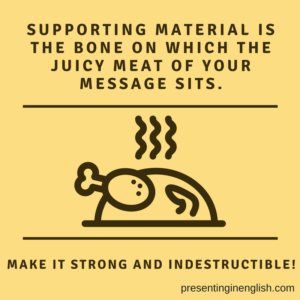
Supporting material is anything you use in your presentation that supports your key message. This can range from statistics to diagrams to anecdotes to video clips. This post will look at verbal supporting material and how to use it. I will cover visual supporting material in my next post on visual aids.
Here’s how I like to develop great supporting material in 5 steps:
- The process for developing good supporting material begins with the brainstorming part of your preparation. Do some research if necessary. Put all your ideas on the table – even the crazy ones.
- Then compare each piece to your key message. Does it really support what you want to say? If not discard it.
- Choose the best pieces to include in your presentation. The number of supporting elements will depend on how much time you have. Try to include a variety of different types of supporting materials, so you don’t kill your audience with quotes.
- Find a logical order for your supporting material. You can group them around sub-messages or present them in a chronological order.
- When you finish preparing you presentation, double-check that all the supporting material still supports your main point and is essential to your presentation.
Supporting material is the bone on which the juicy meat of your message sits. Make it strong and indestructible.
Some examples of verbal supporting material
Quotes: One of the most common supporting materials used in speeches. However, they should be used sparingly and with caution. If you are going to quote someone in a presentation make sure you get the quote exactly right either by reading it or by memorising it, because someone in the audience may recognise it.
Facts: Sharing information from a credible source can help to explain your key message. Scientists, bankers and lawyers are just some of the many professions that rely on facts during presentation. However, be careful not to bore or overload your audience with too many facts. Consider which ones best support your key message and speak in detail on those ones.
Stories/Anecdotes: My favourite type of supporting material. As one of my speaking mentors says “Facts tell, but stories sell”. Stories help you connect with the audience through the emotional part of their brain. As humans were are all wired to enjoy a good story. An effective story that proves your key message is a great tool!
Analogy: This type of supporting material works well when you have a new or complex topic and you want to relate it to something the audience knows and understands. For example, when giving constructive feedback we make an analogy that it should be like a sandwich. Say something positive, something to improve and then again something positive.
Statistics: Again, verified numbers can add credibility to your presentation. However, remember the words of British Prime Minister Benjamin Disraeli, “There are three kinds of lies: lies, damned lies and statistics.” Some people are wary of numbers, so make sure you have the source for your statistic and that the source is credible.
Testimony: If you are trying to sell something or persuade someone, having the testimony of another client, customer or expert can support your message.
Definition: This may be necessary if the topic is new for the audience or if you want to make sure everyone is on the same page.
